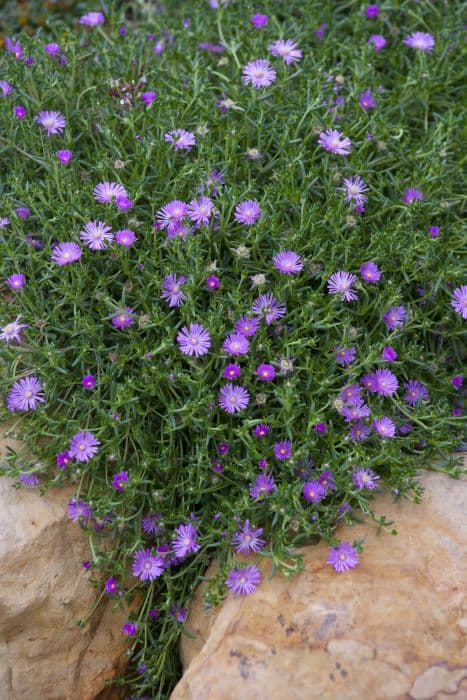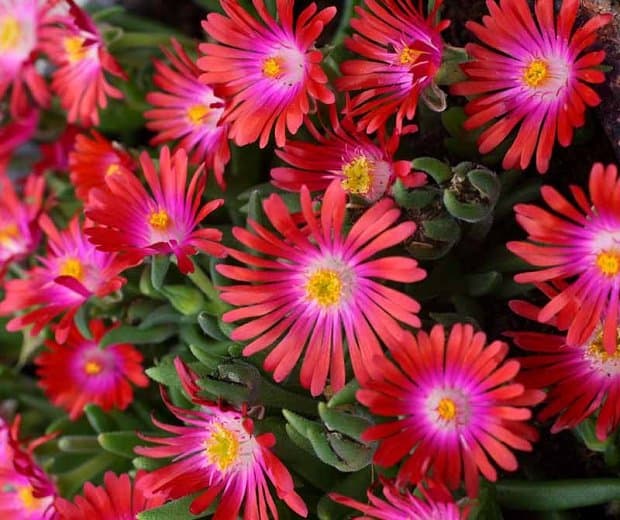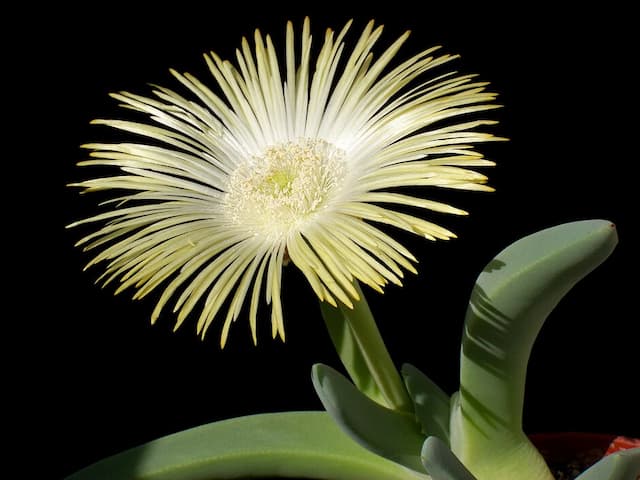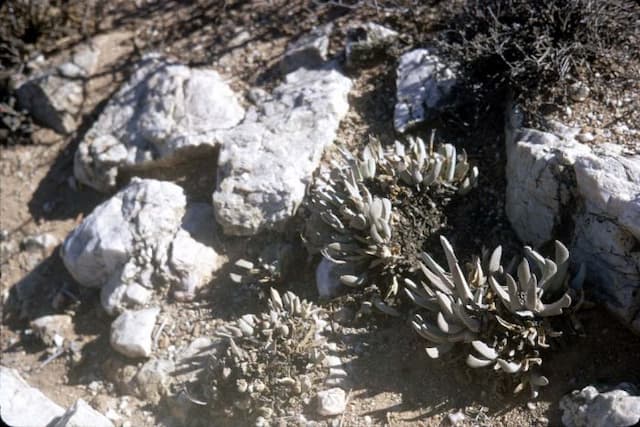Living stones Lithops olivacea

ABOUT
Lithops olivacea, commonly known as living stones, has a distinctive appearance that closely resembles pebbles or small rocks, enabling it to blend into its natural surroundings. These plants are typically made up of two thick, fleshy leaves that are joined at the ground level and almost seamless, giving the impression of a single stone-like structure. The surface of the leaves is smooth with a unique, olive-green coloration that may exhibit varying shades, often with mottled or marbled patterns of a darker tone or even hints of brown or rust, enhancing their stone-like appearance. The living stones have a cleft or fissure at the center, between the leaves, from which new leaf pairs and flowers emerge. The blossoms are daisy-like in appearance, usually coming in shades of yellow or occasionally white, and they bloom close to the ground level within the central split. This cleft may also give the impression of a 'mouth,' contributing further to the anthropomorphic character of the plant. With their minimalistic and surreal look, Lithops olivacea are favored by succulent enthusiasts and those interested in unique, low-maintenance houseplants.
About this plant
 Names
NamesFamily
Aizoaceae
Synonyms
Living Stones, Pebble Plants, Split Rocks, Mimicry Plants, Flowering Stones, Butt Plant
Common names
Lithops hallii olivacea, Lithops ruschiorum olivacea
 Characteristics
CharacteristicsLife cycle
Perennials
Foliage type
Evergreen
Color of leaves
Varies
Flower color
Yellow
Height
1 inch (2.5 cm)
Spread
1 inch (2.5 cm)
Plant type
Succulent
Hardiness zones
10
Native area
South Africa
Benefits
 General Benefits
General Benefits- Low Maintenance: Lithops olivacea, commonly known as living stones, requires minimal care, making it ideal for busy or beginner gardeners.
- Drought Tolerance: Due to their succulent nature, living stones can survive long periods without water.
- Space Saving: Their small size means they take up very little space, perfect for small apartments or as desktop plants.
- Decorative Appeal: With their unique stone-like appearance, living stones add an unusual aesthetic to any plant collection or garden.
- Educational Interest: They provide a learning opportunity about mimicry and adaptation in plants.
- Insect Repelling: While not their primary benefit, some succulents can help repel certain insects from the area they are kept in.
 Medical Properties
Medical PropertiesThis plant is not used for medical purposes.
 Air-purifying Qualities
Air-purifying QualitiesThis plant is not specifically known for air purifying qualities.
 Other Uses
Other Uses- Lithops olivacea, commonly known as living stones, can be used as a learning tool for children and adults to educate them on camouflage and mimicry in plants, demonstrating how this species blends into their surroundings.
- Living stones can serve as an interesting subject for photographers, especially macro photographers, due to their unique textures and patterns.
- These plants are often included in thematic rock garden displays or terrariums, providing an aesthetic that mimics a miniature desert landscape.
- Living stones can be used in feng shui practices, where they are thought to bring harmony into the home by balancing the elements with their earthy appearance.
- As conversation pieces in a home or office setting, living stones often spark curiosity and discussions about plant diversity and adaptation.
- In art, lithops can be used as inspiration for sculptures, paintings, and other forms of mixed media because of their distinct shapes and resemblance to stones.
- They are perfect for drought-prone regions as an example of drought-resistant landscaping, requiring very little water to survive.
- Due to their small size, living stones can be grown in miniature containers, making them ideal for small space living and urban environments where space is limited.
- Lithops olivacea can be given as a gift symbolizing resilience and endurance, due to their ability to thrive in harsh, arid environments.
- They can be used in scientific studies and educational demonstrations that focus on water conservation techniques in arid climate horticulture.
Interesting Facts
 Feng Shui
Feng ShuiThe Living Stones is not used in Feng Shui practice.
 Zodiac Sign Compitability
Zodiac Sign CompitabilityThe Living Stones is not used in astrology practice.
 Plant Symbolism
Plant Symbolism- Resilience: As Lithops olivacea, commonly known as living stones, thrives in harsh, arid environments, it symbolizes the ability to withstand challenging conditions and adapt.
- Camouflage: Their stone-like appearance provides a natural camouflage against predators; thus, they represent protection and blending in with one’s surroundings.
- Persistence: Living stones grow slowly and can live for many years, symbolizing steadiness, patience, and long-term perseverance.
- Self-sufficiency: Due to their minimal water requirements, living stones are associated with independence and the minimalistic use of resources.
- Uniqueness: Their unusual shape and texture symbolize individuality and celebrating differences.
 Water
WaterThe "Living Stones" should be watered sparingly and infrequently. During spring and autumn, water them every two to three weeks with about 1/4 ounce per plant, allowing the soil to dry out completely between waterings. In summer, reduce watering to once a month or less, and during winter, refrain from watering entirely to mimic their natural dormant period.
 Light
LightLiving Stones thrive in bright, direct sunlight. They should be placed in a location where they can receive several hours of direct sunlight each day, such as a south-facing window, to ensure they get the light intensity they need to develop their unique stone-like appearance.
 Temperature
TemperatureLiving Stones prefer a warm environment and can tolerate temperatures between 65°F and 90°F, but they should not be exposed to temperatures below 50°F. The ideal temperature range for their growth is around 70°F to 85°F during the active growing season.
 Pruning
PruningPruning is generally not necessary for Living Stones since they consist of just one or two leaf pairs. However, you can remove dead or shriveled leaves carefully by hand, typically after the new leaf pair has developed and the old pair has dried up, which usually occurs once a year.
 Cleaning
CleaningAs needed
 Soil
SoilThe best soil mix for Living Stones (Lithops olivacea) is a well-draining mixture composed of half sand or fine gravel and half succulent or cactus mix. This blend ensures quick drainage, which is crucial for their health. The soil pH should be neutral to slightly acidic, around 6.0 to 7.2.
 Repotting
RepottingLiving Stones (Lithops olivacea) do not need frequent repotting and can typically remain in the same pot for several years. They should be repotted once every 3-4 years or when it is evident that the current pot no longer accommodates their size.
 Humidity & Misting
Humidity & MistingLiving Stones (Lithops olivacea) thrive best in low humidity conditions similar to their natural habitat. The ideal humidity level for this plant is between 40-50%.
 Suitable locations
Suitable locationsIndoor
Place Living Stones in bright light indoors; water sparingly.
Outdoor
Ensure full sun exposure and protect from excessive rain outdoors.
Hardiness zone
10-11 USDA
 Life cycle
Life cycleLithops olivacea, commonly known as living stones, starts its life cycle as a seed, typically germinating after rainfall in its native desert environment. Upon germination, it develops two succulent leaves which are adapted to store water and endure the harsh climate. Over time, the plant will shed its old leaves and produce new ones, a process that can make it look like a new plant is emerging from the fissure between the old leaves. After a few years of growth, when conditions are favourable, usually in the fall, it will bloom with small daisy-like flowers, signaling its maturity and readiness for reproduction. Once pollinated, the flowers produce fruits containing seeds that are dispersed by wind or water. This slow-growing plant can live for years, repeating its flowering and seed-production cycle while blending seamlessly with surrounding rocks to avoid predation.
 Propogation
PropogationPropogation time
Spring to Summer
Propogation: Lithops olivacea, commonly known as living stones, can be propagated most effectively from seeds. The best time to sow seeds is in the late summer or early fall, which allows them to germinate in temperatures that mimic their native environment. To propagate living stones, first, prepare a well-draining soil mix and place it in a shallow tray or container. Scatter the tiny seeds over the soil surface and lightly cover them with a fine layer of sand or the same soil mix. The container should then be covered with glass or plastic to maintain humidity and placed in a warm, bright location without direct sunlight. Watering should be done sparingly, using a fine mist to avoid disturbing the seeds - just enough to keep the soil slightly moist. Seedlings may appear in a few weeks or take longer, and they should be kept covered until they are large enough to handle the lower humidity of the outside environment.




![Ice plant [Fire Spinner]](/_next/image?url=https%3A%2F%2Fplants-admin.emdemapps.com%2Fimages%2Fplants%2F%2Fimages%2F604b54d98722a.png&w=640&q=75)




